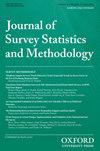Sequential and Concurrent Mixed-Mode Designs: A Tailored Approach
IF 1.6
4区 数学
Q2 SOCIAL SCIENCES, MATHEMATICAL METHODS
引用次数: 0
Abstract
Due to rising costs and declining response rates, surveys are increasingly moving from face-to-face interviewing to a self-administered mixed-mode design. Mixed-mode surveys can be conducted using a concurrent or a sequential design. A sequential design in which the web mode is offered first is a common strategy for mixed-mode surveys as it reduces survey costs. However, when deciding which mode choice sequence to use, sample balance should also be considered. One approach to achieving a balanced sample might be to tailor the sequence of the choice of modes, or the mode choice sequence. For this purpose, we use an indicator that assigns the sampled persons to the different mode choice sequences to minimize the variability of response probabilities. In this study, we compare the sample composition achieved with a concurrent and a sequential design. Additionally, we investigate whether indicator-based tailoring of the two mode choice sequences can improve sample composition. We implemented a randomized experiment in the 2021 German General Social Survey (ALLBUS), which surveyed the general population aged 18 and older in private households (N = 5,342) using a mixed-mode design (web and mail). In a first step, respondents were randomly assigned to a concurrent or a sequential design. We find that the two mode choice sequences lead to a similar sample composition. Next, we identify age as the best available single indicator of the variables known before the survey to tailor the mode choice sequence. Our analyses show that a tailored approach based on age improves the sample composition slightly.顺序和并行混合模式设计:量身定制的方法
由于成本上升和回复率下降,调查越来越多地从面对面访谈转向自填式混合模式设计。混合模式调查可以采用同步设计或顺序设计。在顺序设计中,首先提供网络模式,这是混合模式调查的常见策略,因为它可以降低调查成本。然而,在决定采用哪种模式选择顺序时,还应考虑样本的平衡性。实现样本均衡的一种方法可能是调整模式选择顺序或模式选择序列。为此,我们使用一个指标,将被抽样者分配到不同的模式选择序列中,以尽量减少回答概率的变化。在本研究中,我们比较了同时设计和顺序设计所实现的样本组成。此外,我们还研究了基于指标的两种模式选择序列的定制是否能改善样本组成。我们在 2021 年德国综合社会调查(ALLBUS)中实施了一项随机试验,采用混合模式设计(网络和邮件)对私人家庭中 18 岁及以上的普通人群(N = 5342)进行了调查。第一步,受访者被随机分配到同时设计或顺序设计中。我们发现,两种模式的选择顺序导致了相似的样本组成。接下来,我们确定年龄是调查前已知变量中最佳的单一指标,可用于定制模式选择序列。我们的分析表明,基于年龄的定制方法可略微改善样本组成。
本文章由计算机程序翻译,如有差异,请以英文原文为准。
求助全文
约1分钟内获得全文
求助全文
来源期刊
CiteScore
4.30
自引率
9.50%
发文量
40
期刊介绍:
The Journal of Survey Statistics and Methodology, sponsored by AAPOR and the American Statistical Association, began publishing in 2013. Its objective is to publish cutting edge scholarly articles on statistical and methodological issues for sample surveys, censuses, administrative record systems, and other related data. It aims to be the flagship journal for research on survey statistics and methodology. Topics of interest include survey sample design, statistical inference, nonresponse, measurement error, the effects of modes of data collection, paradata and responsive survey design, combining data from multiple sources, record linkage, disclosure limitation, and other issues in survey statistics and methodology. The journal publishes both theoretical and applied papers, provided the theory is motivated by an important applied problem and the applied papers report on research that contributes generalizable knowledge to the field. Review papers are also welcomed. Papers on a broad range of surveys are encouraged, including (but not limited to) surveys concerning business, economics, marketing research, social science, environment, epidemiology, biostatistics and official statistics. The journal has three sections. The Survey Statistics section presents papers on innovative sampling procedures, imputation, weighting, measures of uncertainty, small area inference, new methods of analysis, and other statistical issues related to surveys. The Survey Methodology section presents papers that focus on methodological research, including methodological experiments, methods of data collection and use of paradata. The Applications section contains papers involving innovative applications of methods and providing practical contributions and guidance, and/or significant new findings.

 求助内容:
求助内容: 应助结果提醒方式:
应助结果提醒方式:


